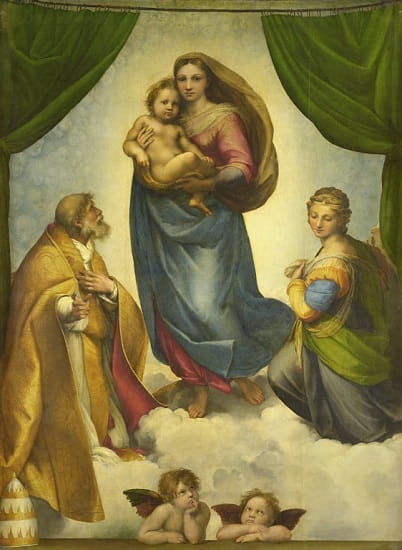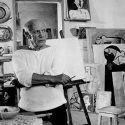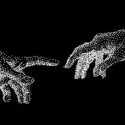10 Famous Renaissance Artworks That Shaped History
The Renaissance, a momentous period in human history, marks a pivotal juncture that ignited the flames of creativity and reshaped the course of art forever. “Famous Renaissance Artworks” stand as timeless testaments to the brilliance of this era, capturing the essence of an age where human potential, intellectual curiosity, and artistic innovation converged to create masterpieces that continue to inspire awe and wonder to this day.
Emerging in 14th-century Italy and reaching its zenith in the 15th and 16th centuries, the Renaissance witnessed a profound revival of interest in classical learning, philosophy, and aesthetics. With newfound curiosity and a voracious appetite for knowledge, artists of the time explored the natural world, human anatomy, and the depths of the human psyche, laying the foundation for a new era of artistic expression.
In this extraordinary journey through “Famous Renaissance Artworks,” we embark on a virtual museum trip, paying homage to the illustrious creations that defined this transformative period. From Leonardo da Vinci’s enigmatic smile in the “Mona Lisa” to Michelangelo’s divine touch in “The Creation of Adam,” each artwork reveals the artist’s unrivaled skill and ability to breathe life into canvas and stone.
Famous Renaissance Artworks
10- The Arnolfini Portrait by Jan van Eyck
“The Arnolfini Portrait,” painted by Jan van Eyck in 1434, is a highly detailed and symbolic portrait of Giovanni di Nicolao Arnolfini and his wife, Giovanna Cenami.

The Arnolfini Portrait, 1434 by Jan van Eyck – Located in The National Gallery – 10 Famous Renaissance Artworks.
Recommended For You – Jan van Eyck and The Details Of The Arnolfini Portrait
The painting’s minutely rendered details and optical precision demonstrate the mastery of the Northern Renaissance artists. The work showcases Jan van Eyck‘s skill in using oil paints and his ability to convey complex symbolism through everyday objects, making it an important example of early Flemish art.
9- The Tempest by Giorgione
“The Tempest” is an enigmatic painting by Giorgione, created around 1506-1508.
The artwork features a woman nursing an infant while a soldier stands nearby and a storm brews in the background. The painting’s meaning remains a subject of debate among art historians, contributing to its mysterious allure.

The Tempest, 1508 by Giorgione – Gallerie dell’Accademia, Venice – 10 Famous Renaissance Paintings.
“The Tempest” is an early example of landscape painting, where the natural environment plays a significant role in the narrative.
8- The Battle of San Romano by Paolo Uccello
Paolo Uccello’s “The Battle of San Romano” is a series of three panels that depict the victorious battle between Florence and Siena in 1432.

The Battle of San Romano, 1435-1460 by Paolo Uccello – Located in The National Gallery – 10 Famous Renaissance Artworks.
The paintings exemplify Uccello‘s fascination with perspective and geometric precision. The use of foreshortening and skillful depiction of horses and soldiers in action make these panels captivating examples of early Renaissance art.
7- The School of Athens by Raphael
“The School of Athens” is a fresco in the Vatican depicting a gathering of great philosophers, scientists, and mathematicians from antiquity. Painted by Raphael between 1509 and 1511, the fresco embodies the harmony and unity of knowledge. It showcases the union of classical thought with the intellectual vigor of the Renaissance.

The School of Athens, 1509-1511 by Raphael – Apostolic Palace, Vatican City – Famous Renaissance Artworks.
Raphael ingeniously combined contemporary figures with ancient philosophers, symbolizing the transmission of knowledge from the past to the present.
6- The Birth of Venus by Sandro Botticelli
Created by Sandro Botticelli around 1484-1486, “The Birth of Venus” is a breathtaking painting depicting the goddess Venus emerging from the sea on a scallop shell.

The Birth of Venus, 1484-1486 by Sandro Botticelli – 10 Famous Renaissance Artworks.
The work exemplifies the revival of classical mythology during the Renaissance and celebrates the beauty of the female form.
Recommended For You – Ancient Greek Gods
The painting’s composition and delicate use of color reflect the grace and elegance of the goddess, making it an enduring symbol of beauty and love.
5- The Sistine Madonna by Raphael
Painted by Raphael in 1512-1513, “The Sistine Madonna” is an altarpiece that portrays the Virgin Mary holding the Christ Child.

The Sistine Madonna, 1512-1513 by Raphael – Famous Renaissance Artworks.
The composition and portrayal of the figures’ expressions evoke a sense of maternal tenderness and divine presence. The two cherubs at the bottom of the painting have become iconic, appearing in various forms in popular culture. This masterpiece captures the essence of spirituality and the ideal of motherly love.
4- David by Michelangelo
Michelangelo’s “David” is a marble sculpture of the biblical hero David, completed between 1501 and 1504.

David, 1501-1504 by Michelangelo – Famous Renaissance Artworks.
Standing over 17 feet tall, the statue exudes a sense of strength, beauty, and idealized human form. “David” symbolizes the Florentine Republic‘s spirit and their desire for freedom and independence. It represents the perfect union of classical aesthetics with Renaissance ideals, becoming a symbol of human accomplishment and artistic perfection.
3- The Creation of Adam by Michelangelo
Part of the Sistine Chapel ceiling, “The Creation of Adam” is one of the most celebrated frescoes ever created. Painted by Michelangelo between 1508 and 1512, it depicts the biblical story of God reaching out to touch Adam’s hand, giving him life.

The Creation of Adam, 1508-1512 by Michelangelo – 10 Famous Renaissance Artworks.
The artwork represents a perfect example of Michelangelo’s skill in depicting human anatomy and emotion. The piece showcases the concept of divine inspiration and the divine spark within humanity, becoming an enduring symbol of human potential and the quest for knowledge.
2- The Last Supper by Leonardo da Vinci
Painted between 1495 and 1498, “The Last Supper” depicts the emotional moment when Jesus reveals that one of his disciples will betray him.

The Last Supper, 1495-1498 by Leonardo da Vinci – 10 Famous Renaissance Artworks.
Recommended For You – 8 Amazing Facts About The Last Supper by Leonardo da Vinci
The painting captures the reactions and emotions of the apostles, making it a remarkable study of human psychology. The use of a one-point perspective and architectural precision further adds to the painting’s significance. Unfortunately, due to Leonardo’s experimental techniques and the passage of time, the fresco has deteriorated.
1- Mona Lisa by Leonardo da Vinci
The “Mona Lisa” is one of the most iconic and enigmatic paintings in art history.
Recommended For You – 15 Facts You Might Not Know About The Mona Lisa

Mona Lisa, 1503-1506 by Leonardo da Vinci – Famous Renaissance Paintings.
Created by Leonardo da Vinci between 1503 and 1506, it portrays Lisa Gherardini, the wife of Florentine merchant Francesco del Giocondo.
The painting’s composition, technique, and the enigmatic smile of the subject have fascinated art enthusiasts for centuries. Leonardo’s use of sfumato (a technique of soft, gradual transitions between tones and colors) and his mastery in capturing subtle expressions have made the “Mona Lisa” a true masterpiece of Renaissance art.
As we draw the curtains on our journey through the captivating world of “Famous Renaissance Artworks,” we find ourselves mesmerized by the sheer brilliance and enduring allure of these masterpieces. The Renaissance era, with its fervent pursuit of knowledge, artistic excellence, and celebration of human ingenuity, bequeathed to us a legacy of artistic treasures that transcend time, geography, and cultural boundaries.
With our hearts open to creativity and our minds awakened to the pursuit of knowledge, let us continue to explore the vast realm of art, uncovering hidden treasures and discovering new stories that will resonate with our souls, just as these “Famous Renaissance Artworks” have done for centuries.
May this journey through art’s Renaissance legacy serve as a reminder that within every brushstroke, every chisel mark, and every artistic expression, lies the power to touch hearts, ignite imaginations, and change the world.
In this expanded conclusion, we reflect on the enduring impact of “10 Famous Renaissance Artworks,” emphasizing their role as beacons of inspiration and their relevance in contemporary culture. By emphasizing the timeless nature of art and its ability to connect us with the past and inspire the future, we leave the readers with a sense of wonder and appreciation for the beauty and significance of art in our lives.
References:
- https://www.nationalgallery.org.uk/paintings/jan-van-eyck-the-arnolfini-portrait
- https://en.wikipedia.org/wiki/The_Tempest_(Giorgione)
- https://www.nationalgallery.org.uk/paintings/paolo-uccello-the-battle-of-san-romano
- https://en.wikipedia.org/wiki/The_Battle_of_San_Romano
- https://en.wikipedia.org/wiki/The_School_of_Athens
- https://artsandculture.google.com/asset/the-birth-of-venus/MQEeq50LABEBVg?hl=tr
- https://en.wikipedia.org/wiki/The_Birth_of_Venus
- https://artsandculture.google.com/asset/the-sistine-madonna/CgEiMJRg7ZS6DA?hl=tr
- https://en.wikipedia.org/wiki/The_Creation_of_Adam
- https://tr.wikipedia.org/wiki/Son_Ak%C5%9Fam_Yeme%C4%9Fi_%28tablo%29
- https://tr.wikipedia.org/wiki/Mona_Lisa








